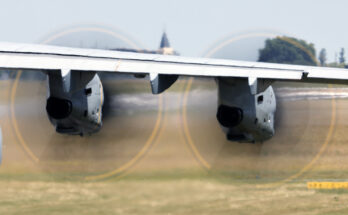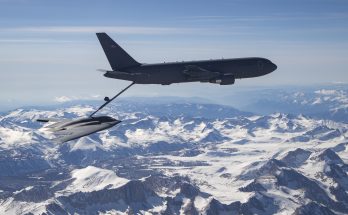
By Dan Darling, Derek Bisaccio and Aja Melville
The war between Russia and Ukraine, initiated by Russia’s invasion of Crimea in 2014 and subsequent invasion in February 2022, has had wide-ranging repercussions, extending beyond the borders of the two nations. This ongoing conflict, coupled with the enduring effects of COVID-19, has exacerbated the division among major economic powers, resulting in a new bifurcated battleground in which China and the U.S. are engaged in a fierce competition.
The economic uncertainty arising from these events has provided China with an opening to expand its influence in regions that have been marginalized by the economic policies of the United States and European Union. As Russia faces economic isolation, China is capitalizing on the opportunity to emerge as a significant player in the Middle East, particularly in the arms export market. Beijing is positioning itself as an alternative economic, political, and defense partner for countries in the region, offering arms sales with a “no questions asked” and “fewer strings attached” policy.
China’s balanced approach in exporting equipment to both sides of the Sunni-Shiite divide, exemplified by its engagement with the Iran-Saudi rivalry, showcases its comprehensive approach to the Middle East. For China, each arms sale to a country typically aligned with the U.S., and successful diplomatic engagement with that country, represents a strategic gain, regardless of whether that country diverges from Washington’s influence or not.
Iranian Rearmament
Chinese arms suppliers typically moved cautiously in their dealings with Iran due to the U.N. arms embargo — that was, until October 2020. After restrictions were lifted, both private and state-owned Chinese firms began to expand their offerings by supplying military assets and technologies to Iran.
The decades-long sanctions, primarily those imposed during the mid-2000s and 2010s, had left Tehran and the Islamic Revolutionary Guard Corps (IRGC) with a stockpile of outdated weapons systems and faulty, reverse-engineered equipment. In 2019, Iran reported it had an $8 billion armaments “shopping list” to address in order to resume modern military operations.
China was quick to offer a slew of unmanned aerial vehicles, which the IRGC has since dispensed to proxy groups throughout Iraq, Syria, Lebanon and Yemen. Many of these Chinese-made drones have been uncovered in strikes against Saudi oil facilities and U.S. outposts in southeast Syria.
In March 2021, Beijing and Tehran entered into a strategic accord calling for closer political, economic and military ties. The 25-year-long agreement sought to piggy-back on the economic opportunity presented by the 2015 Joint Comprehensive Plan of Action, lifting arms embargoes from Tehran and providing opportunity for rearmament.
China has exploited its unique position by fueling the conflict on both sides, arming Saudi Arabia in its struggle against Iranian extremists. This pattern dates back to the Iran-Iraq War in the 1980s, when China emerged as a significant arms supplier to both sides, providing Tehran with nearly half of the total $7.5 billion worth of weapons sold to both parties by the end of the decade, according to the Middle East Institute.
While Russia can fulfill some of Iran’s armament needs, it is unable to meet Iran’s requirements on a large scale. The reported Iranian purchase of Su-35 fighter jets, for example, likely only covers two dozen jets, whereas the Iranian Air Force is believed to have more than 150 operational combat jets, all of which are outdated and in need of eventual replacement.
In the absence of Russia, China’s industry becomes the only one both technically and politically capable of fulfilling Iranian armament requirements. Although there have been no confirmed instances of bilateral arms purchases since the arms ban was lifted in 2020, Iran remains interested in acquiring Chinese weapons, namely the J-10 fighter jet.
Reports have circulated that China is prepared to offer the J-10C as well as the less advanced FC-1 Xiaolong fighter to Iran. The South China Morning Post has estimated the per-unit cost of the J-10 to be between $40 million and $65 million. The primary concern, however, is that Iran cannot pay in dollars or euros; Tehran has instead offered oil and natural gas exchange as payment. The recent economic crisis has led China and other countries to favor cash deals so as to keep their foreign currency reserves robust, leaving Iran with little purchasing power.
Saudi Arabia Caught in the Middle
Unlike Iran, Saudi Arabia has traditionally had a positive relationship with the U.S. in terms of exporting arms. This, in turn, makes Riyadh a more attractive political gain for China. However, the U.S. has historically been reluctant to sell its unmanned combat aerial vehicles (UCAVs) to countries other than its close allies, which did not initially include Gulf Kingdoms. Beijing capitalized on this opportunity, bridging Riyadh’s capability gap by offering its own UCAVs and ballistic missile systems, including the Wing Loong and CH-4.
Although China claims the Wing Loong is an indigenous design, the system is similar to the General Atomics MQ-1 Predator, in service with the U.S. Air Force.
Legal precedent influenced by concerns over human rights and other foreign policy matters has also prevented U.S. sales of the F-35 Joint Strike Fighter, the Terminal High Altitude Area Defense (THAAD) system, the AEGIS missile system, and precision-guided munitions to the kingdom. These large capability gaps coupled with the Saudi Ministry of Defense’s lofty annual $50 billion budget leave room for opportunistic players to develop a strategic alliance.
Though Chinese arms sales to Saudi Arabia have been infrequent, they are highly significant. After acquiring UCAVs, Saudi Arabia immediately began employing them in its air campaign over Yemen. Saudi Arabia furthermore relies on its China-supplied ballistic missiles as a deterrent against Iran.
China has tailored its offerings to Saudi Arabia to align with Saudi industrialization goals. Recent missile cooperation has focused on technology transfer and localized production. Saudi Arabia’s locally produced Saqr drone utilizes Chinese-designed air-launched missiles. Additionally, there has been interest in the JF-17, a joint Pakistani-Chinese fighter jet, with potential plans for its manufacture in Saudi Arabia.
Nevertheless, Saudi Arabia’s broader defense needs have generally been fulfilled by its Western partners. Despite increasing political tensions, the U.S. has demonstrated its commitment to remain the primary arms exporter in the region. During the previous administration, led by Donald Trump, the U.S. proposed a $110 billion arms deal with Saudi Arabia, including significant investments in THAAD systems. In August 2022, the Biden administration approved separate deals for the potential sale of THAAD missile interceptors to the United Arab Emirates and Patriot missile interceptors to Saudi Arabia, valued at $5.3 billion.
Conclusion
China’s emergence as a major player in the Middle East arms market is a noteworthy development, considering its relatively small presence in the past. From 2000 to 2019, the United States maintained its position as the dominant arms exporter in the region, accounting for over 45 percent of imported weapons. In contrast, China’s share only amounted to around 2.5 percent of arms imports during that period.
Manufacturers such as Aviation Industry Corporation of China (AVIC), China Aerospace Science and Industry Corporation (CASIC), China State Shipbuilding Corporation (CSSC), and China North Industries Corporation (NORINCO) are growing into significant players in the international arms market, aiding China’s rise to top-five global exporter.
By offering an affordable price point, flexible payment options, and assurance of delivery to the end user, China has steadily cultivated a customer base across the developing world.
As China continues to ascend as a global power, it is gradually assuming the role that was previously occupied by Russia as the preferred alternative to Western industry as an arms supplier. Arms sales often lead to long-lasting relationships, as buyers not only acquire new equipment but also require servicing and upgrades in the future. China is integrating its arms sales portfolio into its broader foreign policy approach, cultivating ties with friendly partners and even attempting to sway countries away from the Western camp.
This emerging position is expected to have implications for the global balance of power as nations seek to solidify their positions in the evolving international landscape. Russia has inadvertently passed the torch to China, paving the way for it to become the next major power capable of rivaling the United States for global influence.
This article was a collaboration between authors Dan Darling, Director of Military & Defense Markets, Forecast International; Derek Bisaccio, Lead Analyst, International Defense Markets, Forecast International; and Aja Melville, Weapons Editor and Analyst, Military Periscope
Sources:
“Russia Ready to Discuss Arms Contracts with Iran,” Derek Bisaccio, Forecast International, Nov. 20, 2019; “China’s surprising drone sales in the Middle East,” Bradley Bowman, Maj. Jared Thompson, and Ryan Brobst, Defense News, April 23, 2021; “CNN Exclusive: US intel and satellite images show Saudi Arabia is now building its own ballistic missiles with help of China,” Zachary Cohen, CNN, Dec. 23, 2021; “Restrictions on drone exports hamper American foreign policy: Mitchell Institute,”Ryan Finnerty, Flight Global, April 18, 2022; “Chinese and Saudi firms create joint venture to make military drones in the kingdom,” Agnes Helou, Defense News, March 9, 2022; “UN arms embargoes on Iran expire despite US objections,” Nasser Karimi, AP News, Oct. 18, 2020; “Revealed: Trump’s $110 billion weapons list for the Saudis,” Aaron Mehta, Defense News, June 18, 2017; “Attack On Europe: Documenting Russian Equipment Losses During The 2022 Russian Invasion Of Ukraine,”Stijn Mitzer and Jakub Janovsk, Oryx, Feb. 24, 2022; “Iran and China sign 25-year cooperation agreement,” Maziar Motamedi, Al Jazeera, March 27, 2021; “Sukhoi Su-35 fighters for Iran to arrive imminently amid controversy over jet’s combat success,” Norbert Neumann, Shephard News, May 15, 2023; “Top Iranian, Saudi envoys meet in China in restoration of diplomatic ties,” Bernard Orr and Aziz El Yaakoubi, Reuters, April 6, 2023; “Russia and Saudi Arabia loaded weapons with talk,”Ivan Safronov, Kommersant, July 10, 2017; “Qatar Displays Chinese Missile”, Maclyn Senear, Arms Control Association; “As US watches, China and Saudi Arabia shy away from defense deals during Xi’s visit,” Jared Szuba, Al-Monitor, Dec. 11, 2022; “Arms Sales in the Middle East: Trends and Analytical Perspectives for U.S. Policy,” Congressional Research Service, Nov. 23, 2020; “Why is Saudi Arabia looking to China to buy weapons after years of arms deals with the US?,” Kawala Xie, South China Morning Post, Dec. 8, 2022; “Not ‘business as usual’: The Chinese military’s visit to Iran,” Tuvia Gering, Jason M. Brodsky, Middle East Institute, May 16, 2022; “China’s Arms Exports: Up, Up and Away,” Dan Darling, Forecast International, May 9, 2019
For 50 years, Forecast International intelligence reports have been the aerospace and defense industry standard for accurate research, analysis, and projections. Our experienced analysts compile, evaluate, and present accurate data for decision makers. FI's market research reports offer concise analysis of individual programs and identify market opportunities. Each report includes a program overview, detailed statistics, recent developments and a competitive analysis, culminating in production forecasts spanning 10 or 15 years. Let our market intelligence reports be a key part of reducing uncertainties and mastering your specific market and its growth potential. Find out more at www.forecastinternational.com



